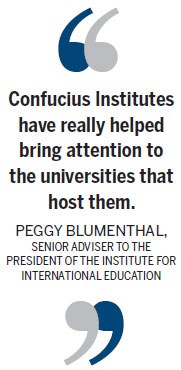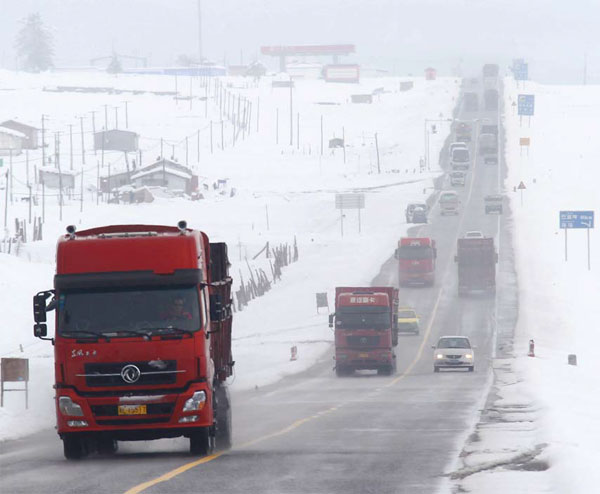Constructing Asia's route to growth

Scaling up infrastructure investment is a vital element of the road map to United nations' development agenda
China's targeted and massive infrastructure spending, one of the hallmarks of its poverty alleviation programs since the 1990s, will play a starring role in the United Nations' plans for sustainable development.
The country's experience, with its long-run economic growth, illustrates the potential impact of infrastructure on promoting inclusive growth and poverty reduction.
| Vehicles navigate a highway in Northwest China's Xinjiang Uygur autonomous region during heavy snowfall in September last year. Targeted and massive infrastructure spending has helped China achieve its poverty alleviation objectives. AFP |
The proposed Sustainable Development Goals, likely to be adopted by the UN in September, include ending poverty and hunger, improving education and combating climate change.
The goals also recognize that developing sustainable infrastructure is "vital to economic development and human well-being".
"Infrastructure is a means to an end," says Zhu Min, deputy managing director of the International Monetary Fund. "It generates new growth opportunities in the manufacturing and services sector, and creates jobs. Trade becomes easier, and countries are in a better position to transition from low- to higher-productivity activities in all sectors."
Speaking to China Daily, Zhu, who was deputy governor of China's central bank before moving to the IMF in Washington, says investing in infrastructure is about helping economies to grow in a sustainable way.
Connection with the world is the defining feature of this century, says Josette Sheeran, president and CEO of the Asia Society, a non-profit organization based in New York.
"While physical infrastructure facilitates trade and personnel exchange, the virtual infrastructure facilitates the delivery of information, education and healthcare," she says.
At present, Asian economies face huge infrastructure challenges, and the deficiencies vary considerably across countries, according to the Asian Development Bank.
The bank says about 1.8 billion people have no access to basic sanitation services, 800 million lack electricity and 600 million do not have potable water. To meet these challenges, the level of infrastructure development must be scaled up.
On the positive side, the ADB says that the region has the potential to match Europe's current standard of living. But this will require an acceleration of infrastructure building. The ADB estimates that Asia needs to invest around $8 trillion in infrastructure in this decade alone.
Infrastructure initiatives
"Industrial development will be crucial in achieving the broader goals of the SDGs, including eradication of poverty and malnourishment," says Rajiv Biswas, Asia-Pacific chief economist at research firm IHS.
He says infrastructure development is "the handmaiden of industrialization", providing the basic requirements of industrial growth such as electricity, water, ports, roads and railways.
For instance, infrastructure development in China has reduced transport costs, encouraged trade and job creation and helped shift labor to non-agricultural activities while promoting inclusive growth and reducing poverty, reports the ADB.
The country, however, has not stopped there.

At the National People's Congress in March, Premier Li Keqiang said that China will invest more than 800 billion yuan ($130 billion) in the construction of 8,000 kilometers of railway tracks and another 800 billion yuan in 84 water conservation projects this year.
Xinhua has reported that the government will also build an additional 7.4 million urban apartments for low-income residents and renovate 3.66 million substandard rural houses.
The development banks can learn from Chinese infrastructure projects like high-speed rail initiatives, says Erik Solheim, chair of the development assistance committee at the Organisation for Economic Co-operation and Development.
"China can sometimes learn from the OECD donors when it comes to financial transparency, environmental standards and consultations with people," he says. "In an ideal world, we would get Chinese effectiveness and speed combined with OECD environmental standards and best procedures for consultation."
The Chinese leadership is also looking beyond the nation's borders and has charted a grand infrastructure development plan for the region.
To strengthen transport networks, China has pledged $40 billion for its New Silk Road Fund for the One Belt, One Road Initiative. This two-pronged project includes the Silk Road Economic Belt, which aims to connect China with Europe via Central Asia by land, and the 21st Century Maritime Silk Road, which will facilitate the development of seaports and maritime connectivity in Southeast Asia and beyond.
The establishment of the China-led Asia Infrastructure Investment Bank, with seed capital of $100 billion, is also part of the massive infrastructure development plan for the region.
"The AIIB is an important step, as with its huge reserve it has the ability to drive the region towards the SDGs and unleash the potential aggregate infrastructure, industrial innovation and inclusiveness," says Venkatachalam Anbumozhi, a senior economist at the Jakarta-headquartered Economic Research Institute for ASEAN and East Asia.
He says the key contribution required from the AIIB is to facilitate "pro-poor growth".
"Beyond mobilizing funds, the bank must ensure that financial services reach out to the millions of 'unbanked', providing them with the opportunities and security of a well-functioning financial system."
The AIIB should invest in the sustainable use of resources, Anbumozhi adds. Providing clean energy, safe water and adequate sanitation can realize multiple dividends in terms of economic growth, poverty reduction and climate change mitigation.
The SDGs propose that all countries should upgrade their infrastructure and retrofit their industries to make them sustainable, with increased resource efficiency and greater adoption of clean technologies and industrial processes.
Many countries in Asia Pacific are already successfully integrating environmental sustainability into their socioeconomic development strategies.
Adopting sustainability
For instance, India is planning an investment of about $1 trillion in "new and clean" infrastructure over the next few years. Innovative solutions are being sought to meet this massive requirement.
Much of the debate around the SDGs concerns the challenge of mobilizing new sources of funding to finance infrastructure projects in developing countries.
The new infrastructure development funds created, such as the AIIB and New Silk Road Fund, will significantly increase the funding available for infrastructure projects in developing Asia, says Biswas of IHS.
As the AIIB also includes wealthy countries from the Middle East and Western Europe among its members, Biswas suggests that these nations could also co-fund Asian infrastructure projects through their state-owned financial institutions.
"China has led the way in terms of mobilizing finance for infrastructure development for developing countries through the creation of the AIIB, Silk Road Fund and the New Development Bank," he says.
Sheeran from the Asia Society says the AIIB should be considered a positive step, as China is showing its leadership and commitment to a multilateral approach to development financing.
"Existing financing agencies can only meet a tiny fraction of the enormous demand for infrastructure financing," she says. "In the marketplace of development financing, if AIIB can bring about additional positive competition, it means resilient infrastructure projects have more options to choose from."
Echoing this view, Zhu from the IMF says multilateral banks, such as the AIIB, add another important source for investment financing. "The issue these banks seek to address - the infrastructure gap in developing countries - is indeed a key constraint to sustainable growth," he says.
"International institutions are akin to developing countries' pit crews, who work together with the driver to keep the show on the road," Zhu sums up.
(China Daily European Weekly 08/14/2015 page15)
Today's Top News
- Japan tempting fate if it interferes in the situation of Taiwan Strait
- Stable trade ties benefit China, US
- Experts advocate increasing scope of BRI to include soft power sectors
- New engine powers cargo drone expansion
- China to boost green industry cooperation
- Manufacturing PMI rises in November































